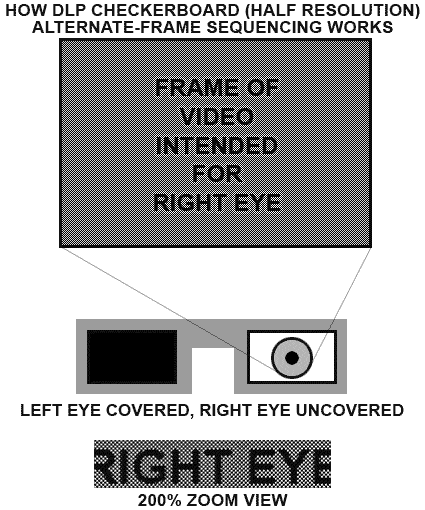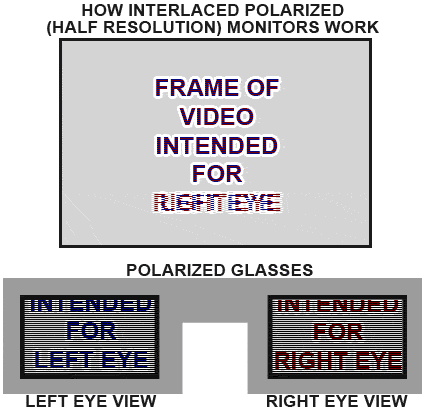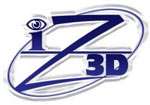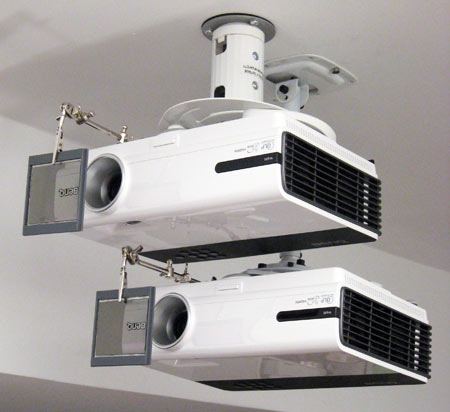Blu-ray 3D On The PC: The Tom's Hardware Review
Tom's Hardware has an exclusive first-look at Blu-ray 3D technology running on a notebook and HTPC leveraging Nvidia's 3D Vision technology, CyberLink's PowerDVD 10 Ultra Mark II software, and an Acer display. Might this setup be in your future, too?
The Other Displays: Half-Resolution Or None At All
There are other commercially available TVs that can display Blu-ray 3D. The problem is that these options are limited to half-resolution output. Let's go over them quickly:
3D Checkerboard DLP Displays
This is a format used on some Samsung and Mitsubishi DLP TVs. It is essentially a variant of alternate-frame sequencing, requiring the same kind of LCD shutter glasses.
Even though these TVs have been sold as “3D-ready” models, they aren't capable of full 1080p resolution because they aren't yet equipped with the HDMI 1.4 specification and can't accept dual 1080p video streams. These TVs cannot handle the bandwidth required for full-resolution, dual-stream 1080p video, but they work around this limitation with the checkerboard 3D format.
The checkerboard technique integrates both stereoscopic views into a single frame of video. Each view occupies alternate pixels of the same image in a checkerboard pattern, so each view uses half the total resolution without losing any complete vertical or horizontal lines of video. The end result is a fairly good 3D image, considering each eye only receives half-resolution, but it still doesn't hold up well to full-resolution solutions like Nvidia's 3D Vision.
Interlaced (Interleaved) Polarized 3D Displays
Hyundai and LG have created interlaced 3D TVs based on this technology, and Hyundai and Zalman have produced polarized PC monitors. Essentially, alternating horizontal lines of video are dedicated to each eye. Each of these lines has its own polarized filter and the user must wear passive polarized glasses. As a result, each eye can only see the lines of video that are intended for that perspective.
Get Tom's Hardware's best news and in-depth reviews, straight to your inbox.
With each eye able to view only every second line of resolution, the downside of this method, you guessed it, is half-resolution. Worse yet, the blank horizontal lines of resolution are easily noticeable, and text can be difficult to read.
Other Display Options
There are at least two 3D display types that I can think of that are theoretically capable of high-resolution Blu-ray 3D playback, but have no software player support announced. Without this support, the potential capabilities of these displays are hamstrung.
The first option I will mention is the iZ3D monitor. Admittedly, the 22" iZ3D monitor only offers 1680x1050 pixels, so it isn't quite capable of 1080p. But it can display 3D video at full resolution. However, as an independent display type without mainstream industry support, the onus will be on iZ3D to work with software developers for Blu-ray 3D playback, or to develop its own proprietary software solution.
The second option is something about which I've gone into great detail in our Wall-Sized 3D Gaming, Just Like The Theaters Do It article. A dual-projector polarized theater would have no problem displaying full 1080p 3D video. The problem is that this is a fringe enthusiast-only method of viewing 3D content, and there aren't any software developers who have announced support for this kind of display.
And that's about it. Of course, there's the old-school anaglyph, red-and-blue-glasses style of 3D, but while the resolution is arguably full 1080p, the color output is so mangled that this is not a viable option for home-theater enthusiasts.
The Display Verdict
No matter how you slice it, there appears to be only a single viable full-resolution Blu-ray 3D option for the PC at this time: Nvidia's 3D Vision solution with 120 Hz LCD screens. Without any other high-resolution options on the horizon, Nvidia will have a virtual monopoly on this high-end format until the competition can offer a viable alternative.
Current page: The Other Displays: Half-Resolution Or None At All
Prev Page Many Display Types, But Only One High-Resolution Choice Next Page Blu-ray 3D Playback SoftwareDon Woligroski was a former senior hardware editor for Tom's Hardware. He has covered a wide range of PC hardware topics, including CPUs, GPUs, system building, and emerging technologies.
-
Annisman The big issue I have with Blu-Ray on the PC is this: There is no free, or reasonably priced software to play Blu-Ray disks. I was pretty much forced to purchase Power DVD 10 Ultra for 110$, as there is no other application that I have found to watch Blu-Ray with. Of course you can 'screw the man' and go pirate Power DVD, but that's probably the main reason I have to shell out over a hundred bucks for the software in the first place. We need an integrated software solution for BD as it is becoming more mainstream. What happened to Blu-Ray playback being included with WMP for Windows 7 ? VLC doesn't even have a solution, what is the reason we don't have 3rd party BD software yet ? Until that is addressed, I can't see Blu-Ray on the PC being viable.Reply -
joytech22 I gotta say i own Nvidia's 3D vision kit + a BD drive + a GTX470 and i just cant wait until the 3D Blu-Ray's are released but first i need to replace my Samsung 2233RZ since the top 15-20% is no longer in 3D.Reply
So far i have had a Very positive experience with Nvidia's solution! -
ajy0903 And also we need to have bigger 3D monitor for PC then what they have currently!!!!!!!!!Reply -
jrazor247 seems most 3d movies are cg currently. probably the entire tool chain to edit and post process digital film has to be upgraded. adding stereoscopic cameras to production is probably the easiest. in a computer generated movie, all the processing can be converted to 3d almost natively in the rendering software. I went to a see the 3d vision setup at a blockbuster near my house. it showed games and animated movies in 3d. the real wow effect came watching footage of people skydiving in 3d. once 3d video production ramps up, its here to stay. i would be addicted to watching sports and performances in 3d. the next road block would be distribution, as the cable and sat providers would have to double bandwidth - artifacts from over compression would def ruin 3d.Reply -
johnb4467 If the hardware settles 7 stabilizes, this is something I would be interested in, whether it's for the PC or the upcoming PS3 firmware update.Reply
I do agree, however, that there needs to be more built-in support for software. I'm sure that will find its way into apps such as XBMC and Plex eventually.
This is going to be hardest for consumers to adopt who have sunk a lot of money into existing HDTV's...especially ones who 'claimed' 120hz refresh rates -- but won't work with 3D. My own TV is a low-end Westinghouse 1080p, so down the road I wouldn't mind upgrading...if the material and quality is there!
FYI: I had older shutter glasses on my old PC & CRT display -- with a fast enough refresh rate...no headaches; it's really not an issue (current demos have confirmed this). -
toxxel I wear glasses already, wearing another pair of glasses over my own is an annoyance. I've never really been a fan of 3D since my eyesight mostly keeps me from seeing anything 3D. I can see nearly perfect out of one eye but the other is another story. My first experience of a 3D polarized movie was Avatar. What I saw didn't impress, blurriness, strange effects from pronounced objects on the screen, felt distracted and ruined many scenes. I understand it's my eyesight that caused problems but I feel 3D won't become main stream simply because of the glasses, but if it were to I'd feel completely alienated seeing I don't have the same experience.Reply -
gti88 Unfortunately, I don't expect the 3d to come to Formula 1 soon. At least, until Ecclestone is no longer in charge.Reply -
jsm6746 this is mostly a rehash of the article you posted by cyberlink's tom vaughan yesterday... i must say i found his article much more informative... the benchmarks were all that was needed in this... the opinion piece was unnecessary... O_oReply
http://www.tomshardware.com/reviews/blu-ray-3d-3d-video-3d-tv,2632.html -
cleeve jsm6746this is mostly a rehash of the article you posted by cyberlink's tom vaughan yesterday...Reply
I disagree with you there. Tom's article is a great Blu-ray 3D white paper, but it's not a Blu-ray 3D review. We did have to duplicate some of the information briefly so this article could stand on its own, but the focus of either article is quite different.
-
cknobman 3d at home can suck it.Reply
New tv's, special glasses, limited viewing angles, new media, new monitors, special software to play them, new blue ray players, etc.., etc...
Not to mention the general discomfort associated with having to watch things in 3d, the fact that 3d is NOT suitable for all situations, many people in the general public have an impairment that wont allow them to enjoy 3d, etc.., etc...
Let this fad fade away and quickly!!! Im not reinvesting thousands and thousands of dollars into this new marketing gimmick. Its another way for the entertainment industry to make even more money off us. Now the push it to make all movies 3d and charge a mandatory 15-20 bucks per ticket to see it.
Its just sad there is such a large portion of the population that mindlessly follows anything presented to them and like zombies will pay what they are told without regard to the cost/benefit ratio.



